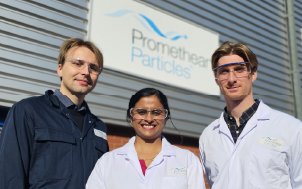Emerging Applications for MOFs
Atmospheric Water Harvesting
Demand for decentralised, off-grid water solutions is accelerating
Climate change and rapid population growth are intensifying the global water crisis. Today, more than 2.3 billion people—nearly one-third of the world’s population—live in water-stressed countries.
Many communities rely on surface water from rivers and lakes or draw from groundwater reserves. But these sources are under increasing pressure from overuse and depletion. Climate change compounds the issue, disrupting rainfall patterns and driving more regions into prolonged drought. Looking ahead, water scarcity may contribute to the displacement of over 700 million people by 2030.
Emerging industrial processes to tackle climate change, including battery manufacturing, hydrogen production and carbon capture technologies, are increasing water demand and intensifying the challenge of water scarcity.
Rethinking Water Infrastructure with Innovative Solutions
Traditional water systems depend on large-scale infrastructure. Reservoirs, pipelines, treatment plants and maintenance all require significant investment and resources. As global water challenges grow, there is a pressing need for alternative methods of water capture and purification.
Desalination offers a potential solution to freshwater scarcity, but its widespread and sustainable use is constrained by the high energy demands and extensive infrastructure required for reverse osmosis and thermal technologies.
One promising opportunity lies in the atmosphere which holds an estimated 12,900 km³ of fresh water, 7% more than Lake Superior, the world’s largest freshwater lake. Accessing this abundant, untapped resource efficiently calls for new technological approaches.
Atmospheric water harvesting (AWH) offers a promising path forward. Among the various AWH technologies, metal-organic frameworks (MOFs) stand out for their ability to operate effectively in self-contained systems across a wide range of humidity conditions. This makes them particularly well-suited for decentralised and remote systems in a range of climatic conditions.
Condensation Cooling

Condensation cooling systems use existing refrigeration and dehumidification processes to chill air below its dew point, causing water vapour in the air to condense into a liquid. Most systems use a vapour-compression refrigeration cycle or thermoelectric coolers to create a cold surface. A fan draws humid air over the cold surface, water condenses and is collected. The water usually requires filtration and UV sterilisation to ensure potable quality.
Advantages
- High water yield in humid areas
- Mature technology
- Modular and scalable systems
- Commercially available
Disadvantages
- Very high energy consumption
- Inefficient below 50% RH
- Not suitable for arid climates
- Require cooling below dew-point
- Require refrigerants
Traditional Adsorbents

Desiccant-based systems use hygroscopic materials (desiccants) to absorb or adsorb water vapor from the air. They can operate at relative humidity as low as 10-30% and outperform condensation cooling in deserts and high-temperature zones. The captured water is released by heating, which can be energy intensive. Desiccant-based systems are promising for a wide range of climates, especially arid regions where condensation-based methods struggle.
Advantages
- Works at lower relative humidity
- Can store water for later release
- Adaptable to semi-arid regions
Disadvantages
- Medium to high energy consumption
- Slow water release
- Require a heat source for regeneration
- Can degrade over time
Fog Harvesting

Not all atmospheric water is vapour. In certain regions, large quantities of liquid water exisits as fog and mist - water droplets suspended in air. Fog harvesting is a passive technique that captures those droplets using mesh nets. When wind-blown fog passes through the nets water droplets collide with the fibres of the mesh and form larger droplets that coalesce and are collected in tanks. The water produced through fog-harvesting is generally high quality and may only require basic filtration.
Advantages
- No external energy input required
- Low maintenance
- Simple and low-cost set up
Disadvantages
- Only works in fog-prone areas
- Water yield highly weather-dependent
- Require a large surfact area
- Ineffective in dry air
Solar Stills

Solar stills harness energy from the sun to produce high purity water from the atmosphere through evaporation
and condensation. They have been extensively used to desalinate water and to produce clean water from nonpotable water sources. The same priciples are being applied to condense fresh water from moist air.
Advantages
- Uses renewable solar energy
- Simple and robust design
- Suitable for remote or desert areas
- Simple technonolgy
- Easy to construct
Disadvantages
- Low daily water output
- Needs brine or moisture source
- Slow collection process
- Ineffective in dry air
MOFs for Atmospheric Water Harvesting
The incredible properties of metal-organic frameworks have put them at the forefront of new developments to harvest water from the atmosphere.
The repetitive lattice structures of MOFs, with their ultra-high surface areas, selectivity and low energies of desorption, make them ideal candidates to enable more energy-efficient atmospheric water harvesting methods.
Promethean Particles’ ability to manufacture metal-organic frameworks at industrial scale marks a major breakthrough in making the use of MOFs in atmospheric water harvesting not only feasible but commercially viable.
WATER HARVESTING NEWS
White Paper – Unlocking Atmoshperic Water
Among various water harvesting technologies being developed, metal-organic frameworks (MOFs) stand out for their...

Ready to discuss how Promethean Particles can help you with your next MOF-based challenge? Contact us to learn more.

